I haven’t written much about Cay lately, so thought I’d give this update. Cayenne and her young littermates were found in the Tennessee wilderness when they were too young to be away from their mother. But their mother was not in sight and they were very sick puppies. They almost didn’t survive a bout of coccidia. A kind man found them and called a local rescue group. Deb took them to the vet who saved them, and helped nurse them back to health. When she had trouble finding homes for 6 of the 7 pups, I was contacted because I volunteered with a national Australian Cattle Dog (ACD) rescue group, and the puppies were thought to be ACD mixes. I helped find rescues in Ontario and Minnesota to take them. Three of the puppies came to Minnesota.
A few months later the Minnesota rescue contacted me and asked me to foster one of the puppies, the only one who hadn’t been adopted yet. This pup was afraid of her own shadow and was terrified at adoption events. She needed more one-on-one time with a person. I had two dogs at home, including a very dominant male Australian Cattle Dog, but I agreed to foster her. “Zulu” came to live with us. When she arrived at our house, it took two of us to pull her out of the crate to get her out of the car. She was plastered to the back of the crate, afraid to come out, and she smelled terrible from urinating on herself. Unlike other dogs I had cared for, she hadn’t had a bad experience with people—she had almost no experience with people. I called her “Cayenne” because she had cayenne pepper-colored highlights and I knew there was some spice inside her somewhere—we just had to find it. She wobbled on an under-developed rear end, with her hocks hyperextending when she walked. Her feet splayed like stars, indicating that she had spent most of her time hiding in a crate and hadn’t had enough exercise. She lacked social skills with the other dogs, crashing into them and barking hysterically when they defended themselves. She had skin allergies and a nervous habit of scratching and licking herself, creating bald patches on her side and rear end. She was afraid of the dark and wouldn’t go outside after dark. What was I going to do with this poor girl?
I let her be a dog and become comfortable in her own skin. We took her along when my other dogs went to herd sheep and cattle. There she got to meet new people who gave her praise and treats, and she saw different kinds of animals. She climbed hills and went on walks every day with my other dogs and me, running and playing in a huge fenced field. Her muscles developed and her coat took on a healthy sheen. After months with us she looked me in the eye one day and, for the first time, I noticed her gorgeous dark brown eyes. I realized then that she had never looked directly back at me before. She had always turned her head away. But now she was looking back and she had the most beautiful dark brown eyes I had ever seen.
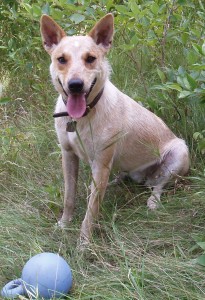
As Cay began to get comfortable in our home and in her own skin, she learned to be a happy, confident dog. She and I completed three levels of obedience classes. During the first class, we worked mostly on getting her used to the other dogs, sounds, and movement around her. She wasn’t comfortable with anything happening behind her and spun around if she heard activity there. But she was very biddable and wanted so much to please me. By the end of the third class she was doing all of the exercises faithfully. Although she had been developmentally delayed since she was a pup, I discovered that she was a very smart dog when she overcame her fears.
One day I let Cay try sheep herding. She was interested and excited that she could move the sheep by turning her body. She was so confident in herself that day that when we got home, she jumped up on my bed for the first time ever! I guess she thought her new accomplishment had earned her that privilege. But sheep herding didn’t sustain her interest for long.
Almost two years after she first came to our home, Cay had come a long way. But she still had nervous energy and habits. I looked for an activity that she and I could do together, separate from the other dogs, to build her confidence and our relationship and help her get rid of her nervous energy without scratching and licking herself. I decided to enroll her in an agility class, even though I didn’t think she would be able to do all of the obstacles due to her poor rear structure.
I had done agility with my other dogs, so I was an experienced handler. The instructor did an individual session with Cay and me to determine her readiness for the class. Cay trusted me implicitly, was very food motivated, and wanted to please me, so she was willing to try everything. Once we started the class, she learned to do the tunnel, low jumps, and even the contact obstacles that challenged her. In the beginning though, she didn’t think she could jump up on the table. I realized this was due to her weak back end, but I also knew that she had learned to jump up on my bed at home, so I knew she could jump that high. I worked with Cay and my other dogs at home, having the others jump on the table first, then giving her the opportunity. With a lot of convincing and some special treats, I taught Cay that she could, indeed, jump up on the table. At first she didn’t think she could, but she proved to herself that she was capable. The next time we went to class, she completed all the obstacles in an agility course. On the last day of class, Cay ran two perfect courses with two clean runs, and was the only dog in the class to do so. Quite an accomplishment for an abandoned puppy who almost didn’t survive, and was afraid of her own shadow, don’t you think? Cay has come such a long way, and agility taught her and me that together we can conquer any obstacle. We start our second agility class soon, and, who knows, maybe we’ll even compete some day. Great job Cay! You have come a long way.
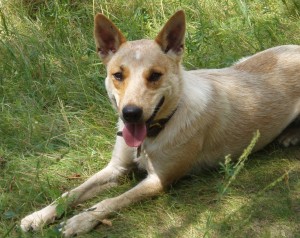
Posted on February 18th, 2010
Filed under: Adopted, Cayenne/ Zulu, General, News | No Comments »
----------------------------------------------------------------
Available this spring!
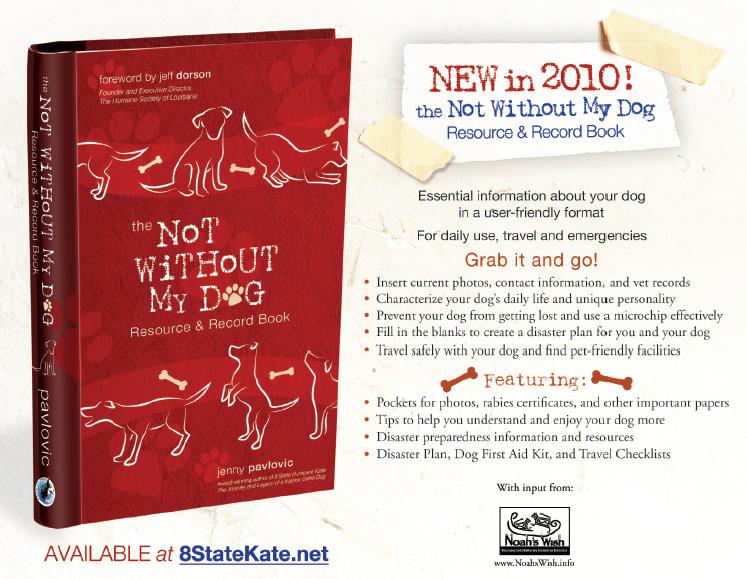
What People Are Saying:
“This book gives us the forms and information we need to protect all our beloved family members. By taking Jenny’s sound advice, you can safeguard the life of your animals in any situation.” — Jeff Dorson, Founder and Executive Director, The Humane Society of Louisiana
“… a customized portable and personal resource filled with empowering, life-saving information. … No dog lover should be without this book.” —Amy D. Shojai, CABC and author of 23 pet care books including The First-Aid Companion for Dogs & Cats
“… an expertly-crafted resource to help dog parents plan for emergencies. With this book, Jenny Pavlovic has given all of us who love our dogs the perfect, user-friendly tool to safeguard their well-being in times of crisis.” —Melanie Monteiro, Dog safety expert, pet first aid instructor and author of The Safe Dog Handbook
“Being in the trenches during the aftermath of Hurricane Katrina has given Jenny the knowledge of the… information that needs to be collected by every pet owner and she makes it easy and fun with this book! We have needed a guide like this for a long time.” —Jeff Marginean, Award-winning author and host of the My Buddy Butch Radio Show
“Every dog should come with this book attached to their collar… Brilliant!” —Barbara Techel, Award-winning author of Frankie (the walk ‘n roll dog) book series, www.joyfulpaws.com
Click here for more images
Posted on February 11th, 2010
Filed under: General | No Comments »
----------------------------------------------------------------
Thursday, February 11th, 6:00 pm CST
Jenny will be on The “My Buddy Butch” Radio Show—listen from anywhere!
http://www.mybuddybutch.com/radio.html
Jeff and I will talk about my new book, the “Not Without My Dog” Resource & Record Book,
coming this spring.
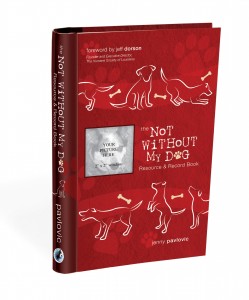
The “Not Without My Dog” book includes essential information about your dog in a user-friendly format for daily use, travel, and emergencies. It has a durable hard cover, fill-in-the-blank records pages, photo sleeves, a waterproof pouch for important papers, and information on keeping your dog safe, disaster preparedness, dog first aid, and more. The 8 State Kate Press produces this book, which is made entirely in the U.S.A.
Posted on February 5th, 2010
Filed under: Book Tour--Virtual, Calendar of Events, Events, General, News | No Comments »
----------------------------------------------------------------
I just watched this nailbiter showing firefighter Joe St. Georges rescuing a dog from a river in L.A (click on link below to watch video).
Firefighter Saves Dog from L.A. River
Fortunately, both man and dog came out of it ok. That is one lucky dog! Thank you Joe St. Georges for taking the risk to save this dog. The dog had a collar, but no tags or microchip, so he is at animal control in Downey, CA. Please, please, please microchip your dog! Here’s more info from the Not Without My Dog Resource & Record Book, coming soon (click here for more info). The book also has a section entitled, “What You Can Do Now to Prevent Your Dog from Getting Lost and to Help You Find a Lost Dog” (coming in another post soon).
What a Microchip Is and How to Use One:
A microchip is a computer chip in a capsule, about the size of a grain of rice, that’s encoded with a unique ID number. It is permanently implanted and can identify your dog if she is lost or stolen. A microchip is the only sure way to identify your dog if the collar is removed or lost, and can provide security and peace of mind.
The microchip is painlessly injected beneath the skin of a dog, usually between the shoulder blades. The chip remains inactive until read by a hand-held scanner that sends a low frequency radio signal to the chip. The chip then transmits an ID number to the scanner. The technology used in microchips is similar to that used in human implants like pacemakers. Since the microchip is powered by the external reader, it is off most of the time and does not require a battery. Thus, one chip is expected to function for your dog’s entire life.
A microchip can be implanted by your veterinarian or at a local animal shelter or humane society. Animal shelters and humane societies often hold low-cost microchip clinics. If your dog has a microchip, you need to register your contact information with the microchip company. Include an out-of-state emergency phone contact since local communication may be difficult in a disaster situation. Keep your dog’s microchip information on file with your veterinarian and update your vet and the microchip company right away when your contact information changes. The microchip can only reunite you with your dog if people know how to reach you. For peace of mind, ask your veterinarian to scan your dog’s microchip at each visit to make sure it is still detectable.
Microchip Basics:
_____ Have a microchip implanted under your dog’s skin. Make sure the implanter scans and reads the chip before and after it’s implanted. Record the chip ID number and company in the front of this book.
_____ Register your contact information with the microchip manufacturer right away. Include an out-of-state contact as an emergency back-up.
_____ Make sure the microchip number and company are filed with your dog’s records at the vet clinic. Ask your vet to scan and check the chip at each visit.
_____ Update the microchip company and your veterinarian immediately whenever your contact information changes.
_____ Make sure your dog wears a collar with ID, the quickest way to identify your dog. The microchip is not intended to take the place of a collar with ID, but is valuable when the collar is lost.
_____ If your dog is lost or stolen, contact the microchip company immediately. Some companies will issue an all-points bulletin to the vet clinics, impounds and animal shelters in your area.
Coming in Spring 2010:
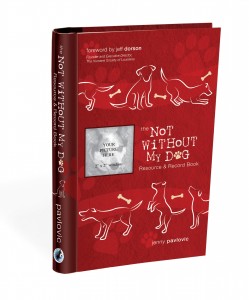
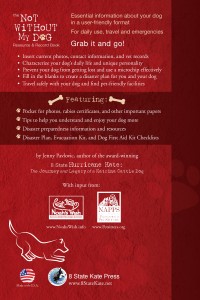
Posted on January 23rd, 2010
Filed under: General | No Comments »
----------------------------------------------------------------
January 17th, 6:00 pm CST
The Pet Playground Radio Show
AM 950, Minneapolis, Minnesota
Click here to listen online from anywhere!
Sage Lewis and I will talk about my new book,
The Not Without My Dog Resource & Record Book,
coming in Spring of 2010.
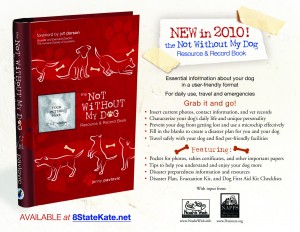
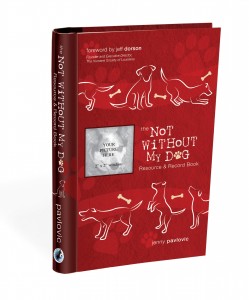
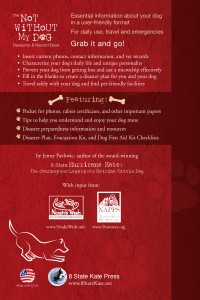
This book was inspired by all that I learned from (and since) my
Katrina animal rescue experiences
and from rescued dog 8 State Kate.
Posted on January 6th, 2010
Filed under: Events, General, News | No Comments »
----------------------------------------------------------------
I’m distressed by the number of “Lost Dog” notices that I’ve received over the holidays. I’ve been writing about this topic for my next book, The Not Without My Dog Resource and Record Book, coming in 2010. I don’t want to wait to share this information, so I’m offering it to you as a “Happy New Year” gift. Remember, please microchip your pets and don’t send them outside without a collar with ID. All my best to you in 2010!
What You Can Do Now to Prevent Your Dog from Getting Lost
And to Help You Find a Lost Dog
The panic and pain of losing a dog might be avoided completely by taking these steps now. If you lose your dog, the tips below may help you to find her quickly.
Socialize your dog: Help your dog get used to different situations, including people and loud noises. A dog that isn’t terrified may be less likely to get lost, and if lost, less likely to hide and easier to find.
Train your dog to wait: Teach your dog to wait while you go out the door first and when you open the crate door. Use a release word to let the dog know when she is free to exit. This will keep your dog from bolting out the door or leaping out of the car before you can snap the leash on.
Train your dog to come when called: Teach your dog to come to you when called. When she comes, reward her with praise and great treats. Never scold a dog you have called, even if she takes forever to get to you. Always make coming to you a good experience.
Train your dog the drop: Teach your dog to drop to the ground on command, so that she might be prevented from running into the street or stopped by your voice if running away. Start by teaching your dog to “drop” at your side and gradually move away so she will do the drop from a distance.
Collar and ID: Make sure your dog wears a secure collar with current ID tags. Include a phone number where you can be reached and a back-up phone number for a second person who can easily be reached by phone.
Microchip: Have an identifying microchip implanted under your dog’s skin at a vet clinic or humane society. Attach a tag with the microchip number to the dog’s collar. Register the chip and make sure the microchip company has your current contact information. Keep a record of the microchip number and the company’s phone number in a safe place (like your wallet) and add it to your dog’s file at the vet clinic. Contact the microchip company if your dog is lost. Some microchip companies will issue urgent bulletins and provide special assistance if your dog is lost.
Photos: Take clear, current photos of your dog from several angles in good lighting. Digital photos are easiest to distribute quickly by e-mail. Store back-up copies with a friend or family member who can access the photos on short notice.
Description: Write a description of your dog as if writing for a person who doesn’t know dog breeds. Include color, approximate weight, and unusual markings or scars. For example, my dog Bandit has a unique cowlick down the middle of his face, a black triangle marking on his tail, and a toenail that sticks out sideways from an old injury.
Info package: Keep an information package about your dog in your vehicle’s glove compartment. Include photos, a written description, microchip info and ID number, contact info and a copy of recent vet records. This book will serve the purpose!
Contact person: Ask a friend or family member to be a contact person, someone who could easily be reached by phone while you were out searching for your dog. The dog could be lost in an area without cell phone reception, and you wouldn’t want to be sitting at home waiting for phone calls when you could be out looking for your dog.
Amber Alert for Pets: I recently learned of an online “amber alert” network for lost pets. I don’t have experience with this network, but you can find more information at www.findToto.com.
The Missing Pet Partnership has helpful pet recovery and “lost dog” poster information on their website: http://www.missingpetpartnership.org.
From The Not Without My Dog Resource and Record Book (© 2010)
by Jenny Pavlovic
available soon from the 8 State Kate Press
Posted on January 1st, 2010
Filed under: General, News | No Comments »
----------------------------------------------------------------
This story was sent to me by The Jenkins Group.
The Inspiring Story Behind the Song “Rudolph the Red-Nosed Reindeer”:
From a depressed widower father, to a millionaire…
How “Rudolph” changed the life of Robert “Bob” May.
(from SocyBerty.com, Nov. 19, 2008)
As the holiday season of 1938 came to Chicago, Bob May, 34-year old ad writer for Montgomery Ward, a father of a four-year old girl, was exhausted, broke, and about to lose his wife to cancer.
One night, Barbara, his daughter asked him, “Why isn’t mommy like everybody else’s mommy?” As he struggled to answer his daughter’s question, Bob remembered the pain of his own childhood. A small, sickly boy, he was constantly picked on and called names. So he began to spin a tale about a reindeer with a bright red nose who found a special place on Santa’s team. Read more…
Posted on December 25th, 2009
Filed under: General | No Comments »
----------------------------------------------------------------
Meet Jenny Pavlovic and Rescued Dog Chase at Valley Bookseller
Â
Saturday, December 19
2:00-4:00 PM
217 N Main Street
Stillwater, MN, 55082
Jenny Pavlovic will sign her award-winning book “8 State Hurricane Kate: The Journey and Legacy of a Katrina Cattle Dog”. Come meet the author and her dog Chase, and share this inspiring story this holiday season. $5 per book sold will go to the 8 State Kate Fund, providing financial relief for animals in desperate situations.
“8 State Hurricane Kate” is a finalist for
2 USA Book News 2009 Book Awards!
Posted on December 11th, 2009
Filed under: General | No Comments »
----------------------------------------------------------------
You laughed, you cried, you were inspired!
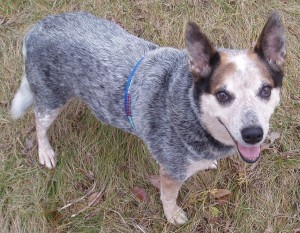
Share “8 State Hurricane Kate: The Journey and Legacy of a Katrina Cattle Dog” this holiday season.
Save $4 per book! That’s just $14.95 each!
Click here to order and enter discount code A43ZX8XR.
A limited number of signed copies are available @ $20 (+ shipping).
To inquire about signed copies, send a message to njennyr @ 8StateKate.net (remove spaces) with “BOOK REQUEST” in the subject line.
Posted on October 30th, 2009
Filed under: General, News | No Comments »
----------------------------------------------------------------
November 14th:
Jenny will speak about:
“How to Discover Your True Passions in Life:
What I Learned from My Journey with 8 State Hurricane Kateâ€
Owatonna Community Education
Owatonna, Minnesota
10:00-11:30 am
Click here and go to page 6 for more info.
Â
Posted on October 26th, 2009
Filed under: General | No Comments »
----------------------------------------------------------------









